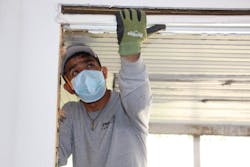Remodeling and home improvement work often means long hours in the sun. Protecting workers from heat exposure is critical to keeping them safe in the summer months.
If a worker overheats, they can suffer heat stroke, exhaustion, rashes, muscle ruptures, fainting, or cramps, according to the National Institute for Occupational Safety and Health (NIOSH).
“Ensuring that your body is regularly hydrated and protected from the sun during hot months is essential to maintaining balance for performing well at work,” NAHB says in its blog. “Workers need to be especially diligent in monitoring their heat levels now as COVID-19 safety protocols call for increased use of face coverings and spending more time outdoors.”
And with climate change shifts local environments, the summers going forward may be even hotter. The United States is already seeing increases in droughts, wildfires, and heat waves in many regions, according to NASA. “Scientists have high confidence that global temperatures will continue to rise for decades to come, largely due to greenhouse gases produced by human activities,” NASA says in its article on the effects of climate change. “The Intergovernmental Panel on Climate Change (IPCC), which includes more than 1,300 scientists from the United States and other countries, forecasts a temperature rise of 2.5 to 10 degrees Fahrenheit over the next century.”
Here are five ways remodelers can adapt and beat the heat:
Know the risk factors and warning signs
In the wise words of G.I. Joe, knowing is half the battle. Risk factors for heat-related illnesses include high temperatures and humidity, direct sun exposure, no breeze or wind, dehydration, heavy labor, non-breathable clothing, heat-radiating equipment, and new workers who aren’t used to the heat, according to the NAHB. By taking steps to address these concerns, you can reduce the risk to your workers.
If a worker does start feeling ill, however, it is good to know the warning signs for different heat-related illnesses. The NAHB identifies two of the most common serious heat-related conditions: heat stroke and heat exhaustion.
Heat stroke symptoms include: major, confusion, loss of consciousness, or seizures. Heat exhaustion symptoms include: headache, nausea, dizziness, weakness, irritability, confusion, thirst, heavy sweating, and a body temperature greater than 100.4 degrees fahrenheit. Watch NAHB’s video in English or Spanish to find out more.
Use OSHA’s Heat Safety Tool app
Need heat mitigation tips or afraid that you’ll forget all the signs and symptoms above? There’s an app for that. The OSHA-NIOSH Heat Safety Tool app for smartphones and tablets allows remodelers to keep a pulse on real-time conditions in the work area.
“The OSHA-NIOSH Heat Safety Tool is a useful resource for planning outdoor work activities based on how hot it feels throughout the day,” OSHA says. “Featuring real-time heat index and hourly forecasts, specific to your location, as well as occupational safety and health recommendations from OSHA and NIOSH.”
The app will give users precautionary recommendations that are tailored to the specific heat-index-associated risks indicated by the current readings.
Hydrate, hydrate, hydrate
Think it’s okay to skip out on water breaks? Up to 60% of the human body is H2O. Working in hot weather can really take a toll on the body by leading to dehydration and other heat-related conditions. Zoro’s “Heat Stress and Hydration” guide recommends that workers drink at least 8 ounces of water every 20 minutes. If the weather is extremely hot or workers are exposed for a long period of time, electrolyte-containing drinks are even better. Think Gatorade, Propel, or other sports drinks.
“These drinks can help replenish electrolytes such as calcium, magnesium, chloride, phosphate, potassium, and sodium that are lost when employees sweat excessively in hot conditions,” Zoro says in its guide. “Since water can't replace electrolytes, sports drinks can help prevent muscle fatigue, cramps, and other potentially dangerous health concerns.”
Build in rest breaks
Feel faint? Take a break–or better yet, build rest breaks into the schedule to prevent overheating. Zoro’s guide says that workers should rest indoors in air conditioning if possible. If not, a shady patch, an air-conditioned truck, or tent with misting devices will do. The length of the break depends on the environmental conditions, and workers who are new on the job may need longer rest breaks and shorter work periods.
Per NIOSH recommendations, you should increase rest periods as temperature, humidity, and sunshine increase; when there is no air movement; if protective clothing is worn; and for work that is more labor intensive.
Acclimate workers to the environment
Before you ran, you walked, and the same principle goes for ensuring that workers are ready to work in the heat. The NIOSH calls this acclimatization: For the first two weeks of work in a hot environment, workers should gradually increase the time they spend exposed. Newer workers or those who are not in shape will need more time than seasoned workers used to a jobsite’s conditions.
“For new workers, the schedule should be no more than 20% of the usual duration of work in the heat on day one and no more than 20% increase on each additional day,” the NIOSH says in its guide. “For workers with previous experience, the schedule should be no more than 50% of the usual duration of work in the heat on day one, 60% on day two, 80% on day three, and 100% on day four.”
The best way to deal with heat-related illnesses is to prevent them in the first place. Make sure that your team has a game plan for how you will segment the day before you start to avoid any workers overheating.
